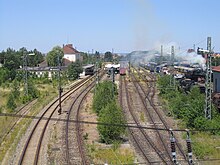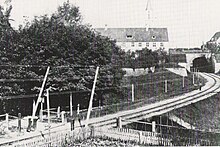Augsburg – Nördlingen railway line
| Augsburg Hbf – Nördlingen | |||||||||||||||||||||||||||||||||||||||||||||||||||||||||||||||||||||||||||||||||||||||||||||||||||||||||||||||||||||||||||||||||||||||||||||||||||||||||||||||||||||||||||||||||||||||||||||||||||||||||||||||||||||||||||||||||||||||||||||||||||||||||||||||||||||||||||||
|---|---|---|---|---|---|---|---|---|---|---|---|---|---|---|---|---|---|---|---|---|---|---|---|---|---|---|---|---|---|---|---|---|---|---|---|---|---|---|---|---|---|---|---|---|---|---|---|---|---|---|---|---|---|---|---|---|---|---|---|---|---|---|---|---|---|---|---|---|---|---|---|---|---|---|---|---|---|---|---|---|---|---|---|---|---|---|---|---|---|---|---|---|---|---|---|---|---|---|---|---|---|---|---|---|---|---|---|---|---|---|---|---|---|---|---|---|---|---|---|---|---|---|---|---|---|---|---|---|---|---|---|---|---|---|---|---|---|---|---|---|---|---|---|---|---|---|---|---|---|---|---|---|---|---|---|---|---|---|---|---|---|---|---|---|---|---|---|---|---|---|---|---|---|---|---|---|---|---|---|---|---|---|---|---|---|---|---|---|---|---|---|---|---|---|---|---|---|---|---|---|---|---|---|---|---|---|---|---|---|---|---|---|---|---|---|---|---|---|---|---|---|---|---|---|---|---|---|---|---|---|---|---|---|---|---|---|---|---|---|---|---|---|---|---|---|---|---|---|---|---|---|---|---|---|---|---|---|---|---|---|---|---|---|---|---|---|---|---|---|
| Route number : | 5300 | ||||||||||||||||||||||||||||||||||||||||||||||||||||||||||||||||||||||||||||||||||||||||||||||||||||||||||||||||||||||||||||||||||||||||||||||||||||||||||||||||||||||||||||||||||||||||||||||||||||||||||||||||||||||||||||||||||||||||||||||||||||||||||||||||||||||||||||
| Course book section (DB) : | 910, 989 | ||||||||||||||||||||||||||||||||||||||||||||||||||||||||||||||||||||||||||||||||||||||||||||||||||||||||||||||||||||||||||||||||||||||||||||||||||||||||||||||||||||||||||||||||||||||||||||||||||||||||||||||||||||||||||||||||||||||||||||||||||||||||||||||||||||||||||||
| Route length: | 70.137 km | ||||||||||||||||||||||||||||||||||||||||||||||||||||||||||||||||||||||||||||||||||||||||||||||||||||||||||||||||||||||||||||||||||||||||||||||||||||||||||||||||||||||||||||||||||||||||||||||||||||||||||||||||||||||||||||||||||||||||||||||||||||||||||||||||||||||||||||
| Gauge : | 1435 mm ( standard gauge ) | ||||||||||||||||||||||||||||||||||||||||||||||||||||||||||||||||||||||||||||||||||||||||||||||||||||||||||||||||||||||||||||||||||||||||||||||||||||||||||||||||||||||||||||||||||||||||||||||||||||||||||||||||||||||||||||||||||||||||||||||||||||||||||||||||||||||||||||
| Route class : | D4 | ||||||||||||||||||||||||||||||||||||||||||||||||||||||||||||||||||||||||||||||||||||||||||||||||||||||||||||||||||||||||||||||||||||||||||||||||||||||||||||||||||||||||||||||||||||||||||||||||||||||||||||||||||||||||||||||||||||||||||||||||||||||||||||||||||||||||||||
| Power system : | 15 kV 16.7 Hz ~ | ||||||||||||||||||||||||||||||||||||||||||||||||||||||||||||||||||||||||||||||||||||||||||||||||||||||||||||||||||||||||||||||||||||||||||||||||||||||||||||||||||||||||||||||||||||||||||||||||||||||||||||||||||||||||||||||||||||||||||||||||||||||||||||||||||||||||||||
| Top speed: | 200 km / h | ||||||||||||||||||||||||||||||||||||||||||||||||||||||||||||||||||||||||||||||||||||||||||||||||||||||||||||||||||||||||||||||||||||||||||||||||||||||||||||||||||||||||||||||||||||||||||||||||||||||||||||||||||||||||||||||||||||||||||||||||||||||||||||||||||||||||||||
| Train control : | PZB , LZB (km 2.7 - 39.8) | ||||||||||||||||||||||||||||||||||||||||||||||||||||||||||||||||||||||||||||||||||||||||||||||||||||||||||||||||||||||||||||||||||||||||||||||||||||||||||||||||||||||||||||||||||||||||||||||||||||||||||||||||||||||||||||||||||||||||||||||||||||||||||||||||||||||||||||
| Dual track : | Augsburg Hbf – Donauwörth | ||||||||||||||||||||||||||||||||||||||||||||||||||||||||||||||||||||||||||||||||||||||||||||||||||||||||||||||||||||||||||||||||||||||||||||||||||||||||||||||||||||||||||||||||||||||||||||||||||||||||||||||||||||||||||||||||||||||||||||||||||||||||||||||||||||||||||||
|
|||||||||||||||||||||||||||||||||||||||||||||||||||||||||||||||||||||||||||||||||||||||||||||||||||||||||||||||||||||||||||||||||||||||||||||||||||||||||||||||||||||||||||||||||||||||||||||||||||||||||||||||||||||||||||||||||||||||||||||||||||||||||||||||||||||||||||||
The Augsburg – Nördlingen line is an electrified main line in Bavaria , which was originally built and operated as part of the Ludwig-Süd-Nord-Bahn from Lindau to Hof . It leads from Augsburg via Donauwörth to Nördlingen .
Between Augsburg and Donauwörth, the route is still part of the national long-distance connection between Munich , Augsburg and Nuremberg . Even after the opening of the high-speed line from Nuremberg via Ingolstadt to Munich, it is still important in long-distance passenger transport. It also serves as a diversion route in the event of disruptions on the new Nuremberg – Ingolstadt section. Due to the few bends between Donauwörth and Augsburg, travel speeds of up to 200 km / h can be achieved as planned.
The further route to Nördlingen , together with the connecting Stuttgart-Bad Cannstatt-Nördlingen railway line, is part of a direct connection between Donauwörth and Aalen and a diversion route from Munich to Stuttgart .
history
The first plans for a railway line from Augsburg to Nuremberg came up shortly after the opening of the first railway line in Germany, Nuremberg – Fürth in 1835. At that time, merchants from the Augsburg area founded a stock corporation for the construction and operation of a line from Augsburg via Donauwörth and Treuchtlingen to Nuremberg. A few years later, however, King Ludwig I announced the construction of a state railway, and the AG had to recognize due to the difficult geological conditions between Donauwörth and Treuchtlingen (Franconian Alb) that an economical construction and operation of a railway line was not possible there society reopened in 1841.
As a result, the Bavarian state government avoided the problem of the Franconian Alb with the routing of the Ludwig-Süd-Nord-Bahn over the Nördlinger Ries . The Bavarian State Parliament decided to build it on August 25, 1843.
- Opening dates
- November 20, 1844: Augsburg-Oberhausen– Nordheim near Donauwörth
- July 1, 1847: Augsburg – Augsburg-Oberhausen
- September 15, 1847: Nordheim near Donauwörth – Donauwörth
- May 15, 1849: Donauwörth – Nördlingen (–Oettingen)
In connection with the construction of the Danube Valley Railway from Ingolstadt to Neuoffingen , the line in Donauwörth was generously re-routed in 1877. The old route east of the old town with the tunnel was abandoned.
On October 1, 1906, the Donauwörth – Treuchtlingen railway line across the Swabian Alb was opened, as had been proposed in 1835. This significantly shortened the railway connection between Munich and Nuremberg. The section between Donauwörth and Nördlingen only started through traffic to Stuttgart.
Construction work to electrify the line from Augsburg to Donauwörth and on to Nuremberg via Treuchtlingen began in 1933 and was completed on May 10, 1935. The section from Donauwörth to Nördlingen and on to Stuttgart has also been electrically operated since 1972.
The first Federal Transport Infrastructure Plan (1973) envisaged, as one of eight expansion projects, an expansion line between Würzburg and Augsburg via Nuremberg. As part of the upgraded Würzburg – Augsburg line, the line was also included in its update, the coordinated investment program for federal transport routes from 1977 and in the urgent requirement of the 1985 federal transport route plan.

The 36.5 km section between Augsburg-Oberhausen and Donauwörth was released in two sections, 1978 and 1981, for speeds of 200 km / h. The expansion section was one of the first routes in Germany on which this speed was achieved.
Following a tender for the so-called E- Netz Augsburg , DB Regio has been using modern railcars in regional transport since 2009. Since then, the lines Munich – Treuchtlingen, Munich – Donauwörth and Donauwörth – Nördlingen – Aalen Hbf have been operated as “Fuggerexpress”.
In November 2018, a three-track expansion for the section between Augsburg and Donauwörth was classified as an urgent need in the Federal Transport Infrastructure Plan 2030. EUR 488 million are budgeted for the expansion of the route.
The Augsburg – Donauwörth section is to be equipped with digital interlockings and ETCS by 2030 as part of the “starter package” of Digital Rail Germany , as part of the TEN core network corridor Scandinavia – Mediterranean .
The Augsburg – Donauwörth section as a test section
The Augsburg – Donauwörth section, which was expanded at the end of the 1970s for a line speed of 200 km / h, is regularly used by DB and private companies as a test route for new technologies in rail traffic.
Since 1977 the section has been equipped with the Sk signal system, with which the Deutsche Bundesbahn wanted to replace the outdated H / V signal system . The introduction of the Ks signals in 1993 made the system superfluous, but the signals are still in operation today.
On October 17, 1984, the 120 001 set a new world record for three-phase vehicles on a presentation drive with three cars (load: around 250 t) at 265 km / h.
In 2001, the prototype of an actively controlled pantograph was tested.
When testing a new, air-sprung bogie for high-speed traffic, a speed of 333 km / h was achieved in 1993.
Route description
course

The route leaves the Augsburg main station in a northerly direction and crosses the Augsburg Local Railway and the Wertach within the city . At Augsburg-Oberhausen station, the lines to Ulm and Welden branched off directly to the west until 1933 , before the branch at the northern end of Oberhausen station was rebuilt. In the urban area of Augsburg, the older route to connect the track construction yard was retained. The line to Ulm swings since 1933 ground-right and then cross the route westward with two Überwerfungsbauwerken. In the further course of the route in the direction of Nördlingen crosses the federal autobahn 8 and the federal highway 2 . The short industrial line to the Lech steel works begins at Herbertshofen . Together with the Ingolstadt – Neuoffingen railway, the line crosses the Danube and reaches Donauwörth from the south.
From Donauwörth to Harburg, the route follows the Wörnitz valley in a north-westerly direction , while the Donauwörth – Treuchtlingen railway , which has been running towards Nuremberg since 1906, leaves Donauwörth in a northerly direction. The Wörnitz is crossed several times with larger bridges in the further course to Harburg. The route then leads almost straight through the Nördlinger Ries to the end point in Nördlingen, which is why this section is also known as part of the Riesbahn .
The old route in Donauwörth broke away from the current route near Nordheim and crossed the Danube a little downstream on its own bridge. The Donauwörth train station was immediately east of the old town. After the station the route ran through a short tunnel and then led in a wide curve westwards. At Wörnitzstein the line crossed the Wörnitz for the first time and then merged into today's route.
traffic
passenger traffic
In long-distance passenger traveled intercity express - and Intercity trains to stretch Augsburg-Donauwörth.
In local transport, the northern section from Nuremberg to Treuchtlingen is served hourly by Regional Express trains, which continue every two hours alternately via Ingolstadt to Munich or Augsburg. Furthermore, the Nuremberg – Treuchtlingen section is condensed to an almost half-hourly service on weekdays by an hourly Regional Express line. There is also an additional regional express line south of Treuchtlingen, which compresses the existing two-hour service to an hourly service.
In rail transport since the timetable change in December 2009, runs between Treuchtlingen and Munich Fugger-Express daily every two hours as a Regional Express (RE). The Fugger-Express runs every hour between Donauwörth and Munich, alternating between the regional express and regional trains (RB). From Monday to Friday it runs in the mornings as a regional train between Augsburg and Meitingen as an amplifier train. In the afternoon, the connection continues to Donauwörth, where there is finally a half-hourly service.
Since the timetable change on December 10, 2006, there has been a direct connection under the name Allgäu-Franken-Express from Nuremberg to Lindau or Nuremberg to Oberstdorf on which diesel multiple units are used, as the section between Augsburg and Lindau or Oberstdorf is not electrified. The three pairs of trains stop occasionally in Treuchtlingen and Donauwörth and thus, after the withdrawal of many Intercity Express and Intercity trains from this route, provide a fast connection from Augsburg to the long-distance traffic hub Nuremberg.
Freight transport
The Märker cement works in Harburg are an important customer in freight transport . They send most of the cement clinker produced there by rail. Large quantities of sugar beet are also transported in autumn. At the beginning of October 2018, around 15,000 tonnes of sugar beet were transported from Nördlingen by Bayernbahn to the sugar factory in Frauenfeld in Switzerland in a total of ten trains .
Vehicle use

Electric locomotives of the series 110 , 111 and 143 with double-decker cars were used in regional traffic until 2009 . Modus cars have also been running on the trains since December 2006 .
Class 440 multiple units (Alstom Coradia Continental) have been operating since the end of 2009 . Class 612 diesel multiple units are used for the Allgäu-Franken-Express .
literature
- Bernd Eisenschink and Jürgen Hörstel: Railways in Southern Germany . Orell Füssli Verlag, Zurich 1990. ISBN 3-280-01897-8 .
- Jörg and Rolf Frank: Treuchtlingen Railway Cross . Bufe-Fachbuchverlag, Egglham 1989. ISBN 3-922138-35-7 .
- Ernst Erhart: Railway junction Augsburg: hub of rail traffic . Geramond-Verlag, Munich 2000. ISBN 3-932785-23-1 .
Web links
- Route, operating points and permissible speeds on the OpenRailwayMap
Individual evidence
- ↑ DB Netze - Infrastructure Register
- ↑ Railway Atlas Germany . 9th edition. Schweers + Wall, Aachen 2014, ISBN 978-3-89494-145-1 .
- ↑ Map of the Federal Railway Directorate Munich 1985
- ^ Rüdiger Block: On New Paths. The new lines of the Deutsche Bundesbahn . In: Eisenbahn-Kurier Special: High-speed traffic . No. 21, 1991, excluding ISSN, pp. 30-35.
- ^ Wilhelm Linkerhägner: New and expanded lines of the Deutsche Bundesbahn . In: Jahrbuch des Eisenbahnwesens , 1977, pp. 78–85.
- ^ A b Rüdiger Block: ICE racetrack: the new lines . In: Eisenbahn-Kurier Special: High-speed traffic . No. 21, 1991, excluding ISSN, pp. 36-45.
- ↑ Three-track expansion of the Augsburg – Donauwörth railway line becomes an “urgent need” - Augsburg Press | News for Augsburg and Bavarian Swabia. Retrieved January 20, 2019 .
- ↑ StadtZeitung GmbH & Co KG: The third track is coming: the line between Augsburg and Donauwörth is to be expanded. Retrieved January 20, 2019 .
- ↑ Digital Rail Germany #####. (PDF) The future of the railroad. In: deutschebahn.com. Deutsche Bahn, September 2019, p. 10 f. , accessed on May 2, 2020 .
- ^ Announcement "Presentation of the BR 120 locomotive - world record of 265 km / h for locomotives with three-phase drive technology" . In: Railway technical review . 33, No. 11, 1984, p. 861 f.
- ↑ Quieter, more flexible and more economical with actively controlled pantographs? . In: Eisenbahn-Revue International , issue 10/2003, ISSN 1421-2811 , p. 446 f.
- ↑ Message ICE runs with air suspension . In: Deutsche Bahn . No. 9/10, 1993, p. 725 f.
- ^ Rieser Nachrichten of March 11, 2006

